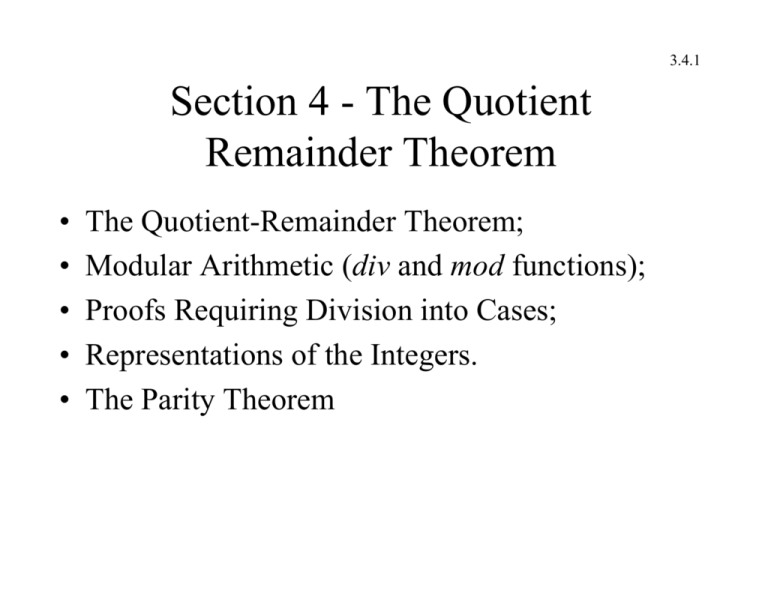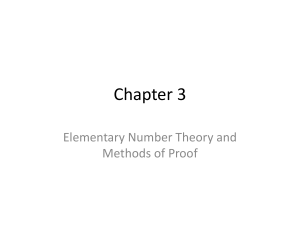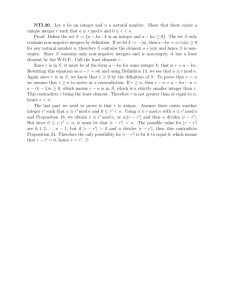Section 4 - The Quotient Remainder Theorem
advertisement

3.4.1 Section 4 - The Quotient Remainder Theorem • • • • • The Quotient-Remainder Theorem; Modular Arithmetic (div and mod functions); Proofs Requiring Division into Cases; Representations of the Integers. The Parity Theorem 3.4.2 Quotient-Remainder Theorem • Theorem: Given any integer n and a positive integer d, there exist unique integers q and r such that: n = d⋅q + r, and 0 ≤ r < d. • Example: If n = 27 and d = 5, then consider: 27 = 0 ⋅ 5 + 27 27 = 1 ⋅ 5 + 22 27 = 2 ⋅ 5 + 17 27 = 3 ⋅ 5 + 12 27 = 4 ⋅ 5 + 7 27 = 5 ⋅ 5 + 2 here, r = 2 and q = 5. 27 = 6 ⋅ 5 + (−3) 3.4.3 div and mod Functions • Definition: Given a nonnegative integer n and a positive integer d, n div d = the integer quotient obtained when n is divided by d; n mod d = the integer remainder obtained when n is divided by d. • Symbolically, if n and d are positive integers: n div d = q and n mod d = r, where n, d, q, and r are as described in the Quotient-Remainder Theorem. 3.4.4 div and mod Examples • Consider the previous example of n = 27 and d = 5. Since 27 = 5⋅5 + 2 yields q = 5 and r = 2, we have that: 27 div 5 = 5; 27 mod 5 = 2. • More: 100 div 10 = 10 100 mod 10 = 0 100 div 8 = 12 100 mod 8 = 4 10 div 100 = 0 10 mod 100 = 10 365 div 7 = 52 365 mod 7 = 1 3.4.5 Representations of the Integers • Recall, we have claimed previously that every integer is either even or odd. • Consider: Even: ... −10 −8 −6 −4 −2 0 2 4 6 8 10 ... Odd: ... −9 −7 −5 −3 −1 1 3 5 7 9 11 ... • We note that all the evens are n = 2q = 2q + 0 and all the odds are n = 2q + 1. • Moreover, each successive integer alternates parity (its mod 2 value). 3.4.6 More Representations of Integers • If we continue representing integers via the Quotient-Remainder Theorem, we observe: Modulus Forms 2 2n 2n + 1 3 3n 3n + 1 3n + 2 4 4n 4n + 1 4n + 2 4n + 3 ... k kn kn + 1 kn + 2 ... kn + (k−1) 3.4.7 Division into Cases • Sometimes when proving a theorem, the logical flow will fork into different directions, each of which need investigation. • This is analogous to needing IF THEN ELSE instead of just IF THEN in programming flow. • An example is the Parity Theorem. • Theorem: Any two consecutive integers have opposite parity. Division into Cases (cont’d.) 3.4.8 Proof: Let m be an integer, so its successor is (m+1). Show m and (m+1) have opposite parity. Case 1 (m even): If m is even, there is an integer k such that m = 2k, hence (m+1) = 2k + 1, thus (m+1) is odd. So, m even implies (m+1) is odd. Case 2 (m odd): If m is odd, there is integer k such that m = 2k + 1. Hence: (m+1) = (2k + 1) + 1 = 2k + 2 = 2(k +1), and so (m+1) is even. So, m odd implies (m+1) is even. Therefore, consecutive integers have opposite parity. QED The Square of an Odd Integer 3.4.9 Theorem: If n is an odd integer, (n2 mod 8) = 1. Proof: Let n be an odd integer, so it has the representation modulo 4 of n = 4q+1 or 4q+3. Case 1: Let n = 4q+1. Thus n2 = (4q+1)2 = 16q2 + 8q + 1 = 8(2q2 + q) + 1. Case 2: Let n = 4q+3. Thus n2 = (4q+3)2 = 16q2 + 24q + 9 = 16q2 + 24q + 8 + 1 = 8(2q2 + 3q + 1) + 1. Therefore, in either case, (n2 mod 8) = 1. QED






